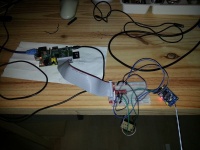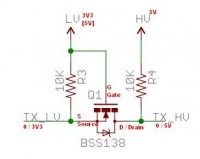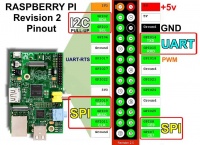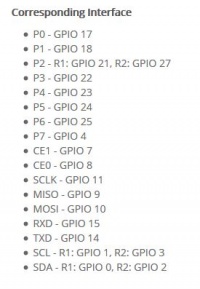Quoi de neuf 2015
From Eric
Experiments carried out in the past (from 2011) are described hereafter:
"Quoi de neuf" means "What's new"...
For 2015, everything is described below...
Contents |
January 2016
- After watching this very interesting video about the Gilbert cell, I have built the following mixer
- As I have used non matched transistors, the mixing is not as symetric as it should be !
December 2015
- Playing with the RPi GPIOs, SPI and CAN: I have managed to drive a MCP2515 CAN controler (through SPI). My RPI is now able to communicate with its Arduino cousins via CAN. It is worth noting that everything can be done in user space, including handling interrupts (thanks to sysfs and the poll(2) system call).
- Beware of electrical levels: the CAN controler is 5V while the RPI is 3.3. I have built a 3.3<=>5v converter using a few BSS138 and >10K resistors (search for "AN10441 Level shifting techniques in I2C-bus" by NXP.com or Adafruit's level shifter). The schema is the following: . Soldering SMT's is not that difficult but the result looks terrible.
- Connector P1:
- The P1 breakout board has the following pinout:
- Activating the SPI is achieved using
sudo raspi-config
- and (possibly) removing the spi_bcm2708 from the blacklist (comment out the corresponding line):
sudo nano /etc/modprobe.d/raspi-blacklist.conf
- GPIO lines can be accessed from a shell script. For instance, switching ON/OFF GPIO4 is achieved as follows:
cd /sys/class/gpio echo 04 > export cd gpio4 echo out > direction echo 1 > value echo 0 > value
November 2015
October 2015
September 2015
August 2015
July 2015
Playing with buildroot and my Raspberry Pi...
June 2015
Nothing.
May 2015
Nothing.
April 2015
No time to do anything about "real electronics".
A few things, anyway:
- I have bought a new RPI 2, installed opencv on it and done a few experiments about line following using Canny and Hough. The idea is to be able to run some benchmark to compare performances of the PI with respect to a Zynq.
- About the Zynq... I have also bought a Zynk board at MyIR. A nice little thingie comes with 1GiO of SDRAM, a Zynq XC7Z020 and many devices (Ethernet, Usb, a buzzer, a CAN adapter, etc.). The board comes with Ubuntu pre-installed. My objective is to run some hard/soft combination at bare metal level. Hopefully, I have found a nice tutorial here.
Building an application on the Zynq is quite complicated since you have to generate the configuration of the FPGA (the bitstream), a FSBL, a specific BSP, your application... to end up with the "boot.bin" file that is loaded by the board. Hopefully, Xilinx' Vivado hide most of the details. It is nice as long as it works...
- I have done a few experiments using SystemC and SystemC AMS (the analog part). You would certainly not replace Spice by SystemC AMS, but SystemC TLM + SystemC + SystemC AMS makes it possible to model and simulate a complete system at different levels of abstraction / models of computation.
March 2015
(see above)
February 2015
(see above)
January 2015
- 10/01/2015
- I have started a small experiment with sound synthesis chips. Right now, I have hooked a YM2612 to an Atmega. My objective is to be able to read and play VGM files.
- To familiarize myself with VGM, I am writing a small VGM parser in Python.
- There are quite a large number of sound synthesis chips: SN76482, the Yamaha family (YM2608, YM2612, YM2149, YMF262, etc.), the AY-3-8912, etc. Wikipedia has a very good set of articles about those sound chips.









